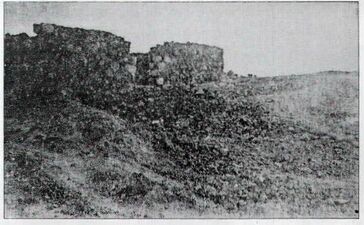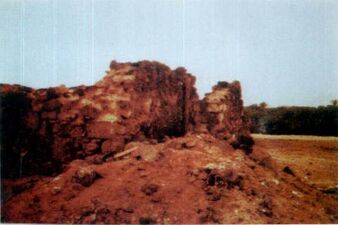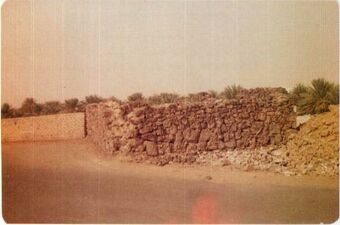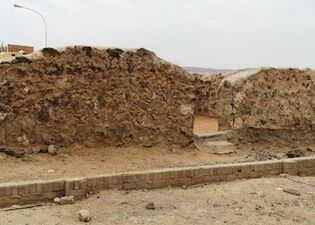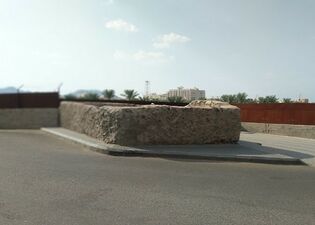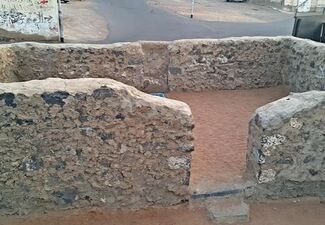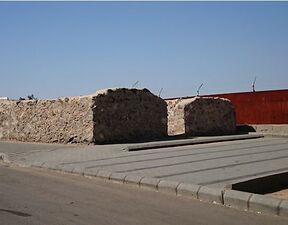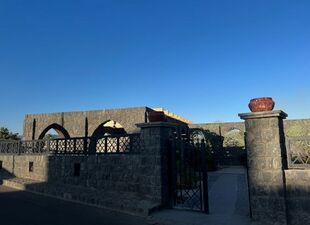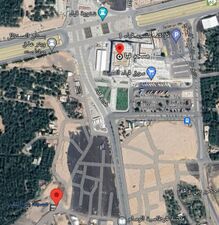Bani Unayf Mosque
 | |
| General Information | |
|---|---|
| Other Names | Masjid al-Musabbih or al-Subh(morning) Mosque |
| Place | saudi arabia, Medina, near the Quba Mosque |
| Usage | Mosque |
| History | |
| Time of Construction | 2021 |
| Events | Performing prayer of the Prophet (S) |
| Current State | |
| Status | Active |
The Bani Unayf Mosque, also known as the Masjid Musabbih or the Morning Mosque, is one of the historically significant mosques located in the city of Medina. This mosque holds particular importance as it was constructed at the site where Prophet Muhammad (S) used to pray. The mosque is situated in close proximity to the renowned Quba Mosque, which further enhances its historical and religious significance.
Throughout history, the Bani Unayf Mosque has faced periods of neglect and ruin. Despite its dilapidated state over the centuries, the site continued to be revered for its association with the Prophet Muhammad (S). In recognition of its historical and spiritual importance, efforts were made to restore and preserve the mosque. These efforts culminated in the reconstruction of the Bani Unayf Mosque in the year 1442 Hijri (2021 CE), ensuring that it stands as a symbol of Islamic heritage and devotion.
The reconstruction project aimed not only to restore the mosque's physical structure but also to revive its historical and spiritual legacy. Today, the Bani Unayf Mosque serves as a place of worship and a reminder of the enduring connection between the present and the time of the Prophet Muhammad (S). It stands as a testament to the rich Islamic history of Medina and the enduring significance of the locations associated with the life of the Prophet.
Location
The Bani Unayf Mosque is strategically located next to the historical fortresses of the Bani Unayf tribe, situated on a hill that provides a commanding view of the surrounding area. It lies a few hundred meters southwest of the Quba Mosque, one of the most significant mosques in Medina. The mosque is also positioned alongside the Ghassan Warehouses and is situated behind the water purification facility for drinking water.[1] This placement not only accentuates the historical and cultural relevance of the Bani Unayf Mosque but also highlights its closeness to notable landmarks and essential facilities in Medina. The elevated site next to the old fortresses reflects the mosque's deep historical roots and its lasting prominence in the Medina region.
Names
The Bani Unayf Mosque derives its name from its location within the settlement area of the Bani Unayf tribe. The Bani Unayf were a sub-branch of the Bani Qilah tribe and, according to some historical accounts, were considered to be descendants of the 'Amaleeqa.[2] This connection to the local tribe not only provides the mosque with its name but also embeds it deeply within the region’s historical and cultural context.
Additionally, the mosque is widely known as Masjid al-Musabbih or the Morning Mosque. This alternate name stems from the significant event of the Prophet Muhammad (S) performing the Fajr (dawn) prayer at this site. The association with the Prophet's early morning prayers has imbued the mosque with a special spiritual significance, making it a revered place of worship and remembrance.
This dual nomenclature reflects both the historical lineage of the local tribes and the religious importance of the mosque, encapsulating its role in the spiritual life of the Muslim community and its rootedness in the history of Medina.
Narrative Accounts
There are three distinct accounts regarding the Prophet Muhammad's (S) prayers at the site of the Bani Unayf Mosque:
First Account
According to the first narration, the Prophet Muhammad (S) performed the Fajr (dawn) prayer at this location upon his migration to the city of Medina. This event marked the beginning of a significant period in Islamic history, as the Prophet established the nascent Muslim community in Medina.
Second Account
The second account states that after Imam Ali (AS) migrated from Mecca to Medina following the Prophet, the Prophet Muhammad (S) performed the Fajr prayer at this location to welcome Imam Ali. This act not only highlights the close relationship between the Prophet and Imam Ali but also emphasizes the importance of this site in the early days of the Muslim community's establishment in Medina.
Third Account
The third narration describes an event in which the Prophet Muhammad (S), during a visit to Talhah ibn Bara', performed a prayer near the fortresses of the Bani Unayf tribe. To commemorate this significant act, the members of the Bani Unayf tribe sprinkled water on the spot where the Prophet had prayed to ensure that its location would be remembered. Subsequently, a mosque was constructed at this site, which came to be known as the Bani Unayf Mosque.[3] These three narrations collectively contribute to the historical and spiritual significance of the Bani Unayf Mosque. Each account underscores different aspects of the Prophet's life and his interactions with the early Muslim community, further enriching the mosque's legacy within Islamic tradition.
Historical Context
Early Accounts
Historical records attest to the existence of the Bani Unayf Mosque across various centuries. Notable scholars and historians such as Matari (673 AH), Firoozabadi (729 AH), Abu al-Baqa' al-Maki (854 AH), Samhudi (911 AH), and Abbasi have all documented this mosque in their writings. In the early 14th century, Ali ibn Musa described this mosque, stating:
"On the Harrah, adjacent to a garden known as 'Qawim,' there lies a small, roofless mosque referred to as Musabbih. When the Prophet Muhammad (S) migrated to Medina, this mosque was situated along his route." This description highlights the mosque's historical significance and its enduring presence along the route of the Prophet's migration to Medina. The references by these early scholars underscore the mosque's importance in Islamic history and its continuous recognition by prominent figures over the centuries.
Reports from the 14th and 15th centuries
Khayyari (1380 AH) provides a detailed description of this mosque, stating: "This mosque is situated adjacent to the Ghassan Warehouses, to the southwest of the Quba Mosque. To its west lie the forts of Musabbih and Thaniyat al-Wada', where the Prophet Muhammad (S) was welcomed by the inhabitants of Mecca." Ibrahim Ayyashi remarks: "From the vestiges of this mosque, I discovered only a structure located on an elevation of Harrah (rock), south of a nearby well. This location is presently known as Musabbih, named so because the Prophet (S) prayed here in the early morning."
Sabagh (1420 AH), after referencing the mosque's location as southwest of the Quba Mosque according to "Wafa' al-Wafa," states: "The mosque features a structure with a height of two meters and is roofless, containing a very small mihrab within." He further elaborates on the reason for the mosque's name, Musabbih, by quoting the narration of Asim ibn Suyyad, and identifies the mosque's location as "adjacent to the Ghassan Warehouses, on the path leading to the lands of Sheikh Abdulhamid Abbas (known as Abbasieh), which were historically renowned as Qaem." These historical accounts collectively enrich our understanding of the Bani Unayf Mosque's significance and enduring presence through the centuries. The detailed descriptions provided by these scholars offer valuable insights into the mosque's architectural features, its geographic context, and its association with key events in Islamic history.
Report by Engineer Kakaei in the Contemporary Era
In the early 15th century, the Bani Unayf Mosque endured multiple episodes of destruction. Nevertheless, due to the unwavering dedication of benevolent patrons, the mosque was repeatedly restored. The most recent reconstruction was undertaken in the year 1427 Hijri (2006 CE). This reconstruction was meticulously planned to preserve the mosque's original site, involving the elevation of its walls to a height of one meter and eighty centimeters.
Engineer Kakaei conducted site visits in the years 1413 and 1429 Hijri, meticulously documenting the mosque’s condition through a series of photographs. His comprehensive visual records provide invaluable insights into the mosque's structural integrity and the progress of its various restoration efforts.
These contemporary endeavors and the meticulous documentation by Engineer Kakaei underscore a sustained commitment to preserving the Bani Unayf Mosque's historical and religious significance. The persistent reconstructions are a testament to the dedication to maintaining this site as a vital part of cultural heritage and spiritual legacy.
Gallary
Images before Reconstruction
Images after Reconstruction
-
The position of the Bani Unayf Mosque in relation to the Quba Mosque.
Notes
References
- ʿAbdu-l Ghanī, Muḥammad ʾIlyās. Al-Masājid al-Atharīyya fī al- madīna al-munawwara. Medina: [n.p], 2000.
- Khīyārī, Sayyid Aḥmad Yāsīn.Tārīkh maʿālimal-madīna al-munawwara qadīman wa ḥadīthan. Riyadh: al-Amāna alʿāmma li-liḥtifāl miʾat ʿām ʿalā tʾsīs al-mamlika al- ʿarabiyya al-suʿūdiyya, 1419 AH/1999.
- Maṭarī, Muḥammad b. Aḥmad al-. Al-Taʿrīf bimā ʾānasat al-hijra min maʿālim dār al-hijra. Riyadh: Dār al-malik ʿAbdu-l ʿAzīz, 2005.
- Samhūdī, ʿAlī b. ʿAbd Allāh. Wafāʾ al-wafā bi akhbār dar al-Muṣṭafā. Edited by Muḥammad Muḥyi al-Dīn ʿAbd al-Ḥamīd. Beirut: 1984.
